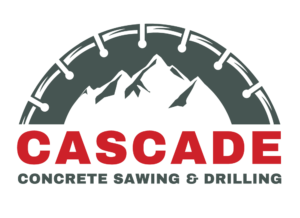When you need to cut into a large, flat concrete slab, slab sawing has presented itself as a far superior option than jack hammering.
Also referred to as flat slab sawing, it’s one of the most common diamond-cutting methods. A large diamond blade is mounted on a walk-behind machine and operated by simple handles and switches.
It’s a clean, efficient means of modifying a wide variety of concrete slabs and horizontal surfaces. Common applications include roadways, parking lots, bridge decks, and floors.
Here at Cascade Concrete Sawing & Drilling, our services include:
Exterior Slab Sawing
Exterior Slab Sawing is typically used to cut concrete in many areas of construction:
- Control joint cutting in newly poured concrete slabs
- Removal of damaged concrete and asphalt pavement sections
- Exterior utility installation, upgrades and repairs
- Demolition cutting for selective slab or wall removal
- Curb, gutter and sidewalk cuts for new driveway approaches
- French drains
- Bridge deck repair
- Highway and runway repair
- Patio and pool deck reconstruction, repair and pour back
- Architectural and decorative saw cutting of patterns
Interior Slab Sawing
Electric and hydraulic saws are the ideal solution for indoor work areas with low ventilation. They also leave a minimal footprint on the environment. Electric slab saws allow Cascade Concrete Sawing & Drilling to provide our customers with cutting depths up to 24” deep.
Our 480 volt saws can run off of their own generator or be wired into a nearby electrical panel. This is an important feature of our electric saws because of its ability to perform interior work efficiently and with high production, zero emissions and without infringing on the air quality of the work area.
Concrete Grinding
Cracks, uneven areas where two existing concrete pours meet and crumbling concrete surfaces don’t get better with time. Chances are that you are probably having a problem with a raised sidewalk, driveway or other concrete slab with uneven or rough surfaces.
Cascade Concrete Sawing & Drilling offers dust-mitigating concrete grinding services using highly-specialized tools to repair cracks. It’s one of the quickest ways to level your concrete floor imperfections on warehouse slabs, commercial buildings, building complexes as well as walkways to eliminate tripping hazards.
Cascade understands these liability issues. We will work with you to grind down high spots and uneven edges with minimum disruptions.
Concrete Slab Sawing FAQs
What is concrete slab sawing?
Concrete slab sawing, also known as flat sawing, is the process of creating a cut through the upper portion of concrete. It is called slab sawing because horizontal installations of concrete are often called slabs. Slab sawing is often completed on grade floors, which is a concrete slab installed on top of a stone base. But we can also work on asphalt or other hard surfaces.
What is the easiest way to cut a concrete slab?
To cut through a concrete slab we use a large diamond blade mounted on a walk-behind machine, and operated by simple handles and switches. Our saws cut up to 24″ deep. This is the cleanest, most efficient way to cut horizontal surfaces.
What is the purpose of concrete sawing?
Typical applications for this type of concrete cutting include cracked or raised surfaces, patching concrete, plumbing installations, creating openings for staircases, and more. Concrete sawing typically requires a special diamond blade to cut through heavy-duty concrete surfaces. As opposed to traditional jackhammering, it allows for much cleaner cuts and straight lines.
What is the difference between slab sawing and wall sawing?
Slab sawing involves cutting a horizontal surface–or “slab”–while wall sawing involves cutting vertical walls. Slab sawing involves a walk-behind saw machine while wall sawing uses a track mounted saw. Slab sawing can be used for cracked or raised concrete.
Which cities does Cascade Concrete offer slab sawing services?
While our main office is located in Federal Way, we serve the Puget Sound and the western Washington area including Bellevue, Federal Way, Kent, Olympia, Puyallup, Seattle and Tacoma.



